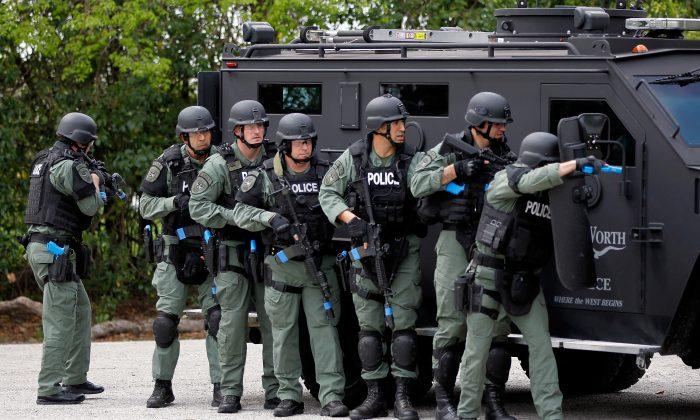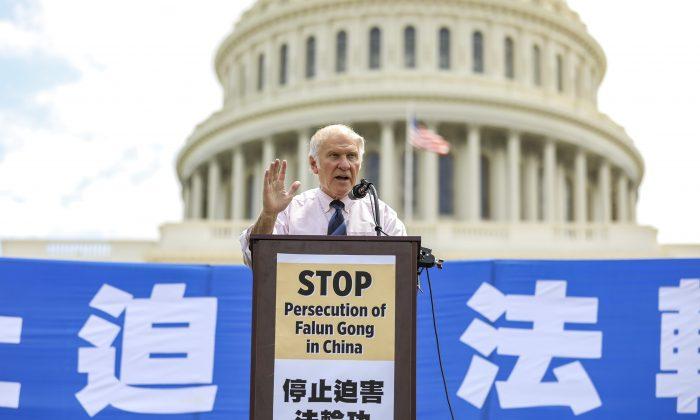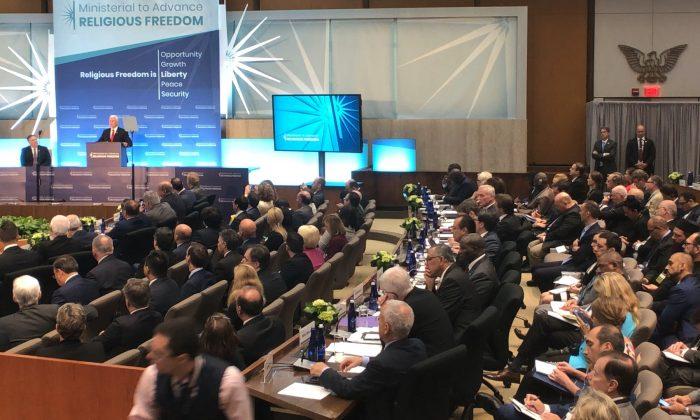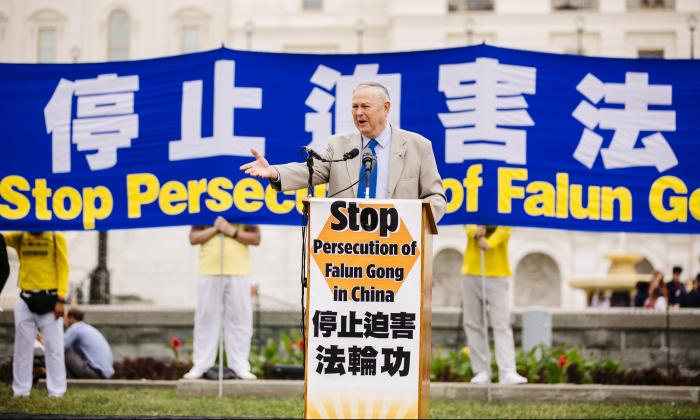WASHINGTON—The line between military combat forces and civilian policing has been eroding in the last 30 years. SWAT teams are ubiquitous in urban centers, and even prevalent small towns, suburbs and exurbs. Our cops get military training and use equipment designed for war. Many in law enforcement are fine with this trend. Others are disturbed by the change in the character of civilian police.
Speaking on Capitol Hill July 24 at an event sponsored by the libertarian think tank Cato Institute, Radley Balko made the case that this trend has led to numerous tragic outcomes of innocent people killed in SWAT raids. According to him, police typically show little remorse. They are unwilling to change procedures to avoid the same mistakes. Further, the SWAT team raids challenge the guarantee of the Fourth Amendment that one’s home is a sanctuary and an individual can protect himself from intruders.
Balko wrote the Rise of the Warrior Cop: The Militarization of America’s Police Forces, published July 9. He argues that policies begun in the Nixon-era war on drugs have blurred the difference between soldier and police officer.
Balko wrote “Overkill: The Rise of Paramilitary Police Raids in America,” published by Cato in 2006. His evidence comes mostly from culling local newspaper accounts of botched SWAT team raids.
A long tradition that Balko traced back to the Posse Comitatus Act (1878) prohibits using the military for civilian policing. The mindset of a soldier and a policeman were regarded as totally different. The formation and proliferation of SWAT teams has been a breach in that tradition, he says.
Article Continues after the discussion. Vote and comment
[tok id=680425d49fdd930e1b0f88f1b683cdab partner=1966]Excessive Force
Balko gave examples of innocent people being killed in SWAT raids.
In “Overkill,” he began with the case of Anthony Diotaiuto in Sunrise, Fla.
Diotaiuto, bartender and part-time student, sold an ounce of marijuana to an informant. Aside from a conviction for possession when he was 16, he had no criminal record or history of violence, wrote Balko.
A SWAT team came at 6:15 a.m. to his home to serve a search warrant. They broke down the front door and used a flash grenade designed to disorient. A few moments later, Diotaiuto lay dead in a bedroom closet from 10 bullets. The police said they found two ounces of marijuana. By the time of the jury trial, that was determined to be 16 grams, a little more than half an ounce.
Accoridng to Balko, the police said they announced themselves before breaking down Diotaiuto’s door. They said he fled to the bedroom for a handgun, and initially said he pointed the gun at the officers. Later, the Sunrise police spokesperson said simply that the weapon was found next to the body.
Balko’s point was that the SWAT team raid was overkill. If Diotaiuto had known the intruders were police it is unlikely that he would have fled to his bedroom to arm himself, given the small amount of marijuana in his possession, he wrote.
Much less likely would he point a gun at the police for the amount of drugs he had; had he lived it would have only merited a misdemeanor charge.
In all likelihood, Balko suggested that Mr. Diotaiuto may have been awakened from a deep sleep, didn’t hear the police announcing their presence, and was disoriented from the flash grenade. He didn’t know that the armed intruders breaking down his door were law enforcement and he “retrieved his gun to defend himself and his property.” The outcome was not unexpected in “a highly volatile situation.”
Balko said that botched raids such as this one are not “isolated incidents.” Other examples of SWAT teams misused are the hundreds of raids conducted each year at a wrong address. Often the people targeted are completely innocent, unlike in the Diotaiuto tragedy. Further, the “no-knock” and “quick-knock” raids often rely on anonymous tips and “dubious informants to obtain the search warrants.”
The raids are intended to terrify. The police generally break down the doors with a battering ram or blow them off with explosives. Sometimes police use a flash bang grenade. Once inside, police force the occupants to lie prone, generally at gunpoint.
Balko said there is a legitimate use of SWAT teams and forced entry, when there is an immediate threat to lives, such as hostage situations, but these occasions are “exceptionally rare.” Using SWAT teams for the “routine execution of drug warrants,” is inappropriate and disturbing, he wrote.
Balko said today many police departments serve every search warrant with the SWAT team.
Balko mentioned a case in Dallas where at the Veterans of Foreign Wars hall was conducting charity games that were not in compliance with Texas law. A SWAT team handled the situation.
Balko wrote in Overkill, “The idea of sending battalions of men dressed, trained, and armed like soldiers to do civilian police work should give us great discomfort.”
Mark Lomax, Executive Director of the National Tactical Officers Association, said Balko’s anecdotal evidence of SWAT team abuse was unduly critical of an effective approach to policing, but he agreed that the deployment of SWAT teams should be limited. His organization will study the improper procedures and practices used by tactical units.
Military Policing
SWAT originally meant Special Weapons Attack Team but was changed to Special Weapons and Tactics to soothe people’s concerns about the word attack. Los Angeles police chief Daryl Gates is credited with first developing SWAT teams in the 1960s as elite teams to handle particularly dangerous situations. They were used for extraordinary situations such as shootouts with the Black Panther militia and the Symbionese Liberation Army in 1974.
In the 1980s President Reagan authorized a militaristic approach to combating drug crime. He signed a directive that stated that drug trafficking was a threat to national security.
Joint tasks forces were created where “police forces were working directly with the military and drug interdiction efforts,” Balko said. “Reagan starts making military equipment available to police agencies to use,” and this expanded in the late 1980s and 1990s.
SWAT team deployments began to take off in the 1980s. Balko cited criminologist Peter Kraska, from Eastern Kentucky University. Kraska computed that a few hundred raids occurred annually in the late 1970s. The number grew in the early 1980s to 3,000 annual SWAT deployments. By 2005—the most recent data available—Kraska said the number is 50,000 raids per year, according to Balko.
SWAT proliferation changed the rest of the police force. It has introduced military equipment and the military mindset to the whole force. For example, he writes, “Patrol officers in Indianapolis are now armed with M-16 rifles supplied by the military… Several Chicago-area police departments use the M-16 as well.”
At the Cato event, Balko mentioned Sheriff Leon Lott from Richland County, S.C., whose department acquired an armored personnel carrier with a belt-fed, .50-cal turreted machine gun from a Pentagon giveaway program.
“It is completely inappropriate for domestic policing,” Balko said.




